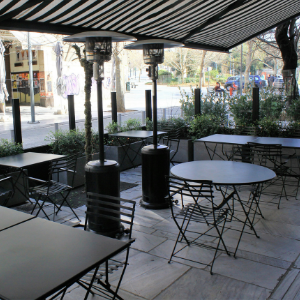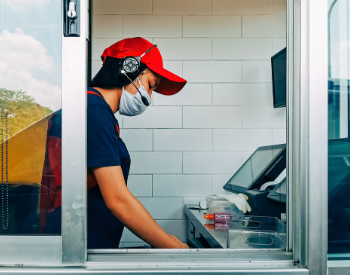Stats Of The Week
The State Of The Industry
According to the National Restaurant Association, 14 states lost restaurant jobs in August. In the previous three months, the restaurant industry had added nearly 3.5 million jobs, but in August, job growth slowed down significantly. The five states that lost the most restaurant jobs are California, Florida, New Mexico, Tennessee, South Carolina, and Alaska, with 25% fewer people on payroll in August than in February. However, restaurant employment recovery varies substantially state by state with South Dakota, Maine, Indiana, Idaho, and Mississippi already seeing restaurant employment levels recover from the job losses from the pandemic.
The Future Of Outdoor Dining During Winter
Over spring and summer, restaurants were able to gain some lost revenue from offering outdoor dining by optimizing patios, sidewalks, and parking lots. Now, with fall and winter on the way, restaurants are looking for solutions to keep outdoor seating as an option while the weather gets cooler. Research conducted by the NRA shows that a majority of operators offer outdoor dining and plan to continue doing so for at least two more months. On average, full-service operators say 44% of their restaurant’s daily sales now comes from on-premises outdoor dining. In the limited-service segment, operators say on-premises outdoor dining represents, on average, 25% of their current daily sales. 49% of full-service and 25% of limited-service operators say they are taking actions to extend the outdoor dining season for their restaurants, including installing tents or patio heaters.
What’s Trending
Indoor Dining Reopens For NYC Restaurants But It Won’t Be Easy
Earlier this month, New York Governor Andrew Cuomo announced plans to allow restaurants in NYC to reopen indoor dining at 25% capacity. Along with limited capacities, NYC restaurants must adhere to strict guidelines that are having operators question whether the investment to reopen dining rooms is worth it. Restaurants must uphold capacity limitations, place tables six feet apart, take temperature checks, gather customer information for contact tracing, and upgrade their establishment’s air filtration. The city will be enforcing these guidelines with 400 additional inspectors. If restaurants adhere to these guidelines, the city will expand capacity restrictions to 50% on November 1.
Are Ghost Kitchens The Solution?
At the beginning of 2020, the idea of ghost kitchens seemed like a concept that would take off in the far away future, but now in the midst of the pandemic, it seems to be the solution for restaurant recovery. Independent restaurants are particularly struggling with the loss of dine-in services and are looking to ghost kitchens as a way to make ends meet. A multitude of quick-service restaurants have also hopped on this trend and are utilizing their establishment to operate a ghost kitchen on top of their day-to-day functions. However, operating a ghost kitchen is more complicated than it seems.
Kristen Barnett, Director of Strategy for Zuul Kitchens, told Restaurant Business that the best concepts are those that understand how achieving digital sales works, digital marketing, and how their restaurant and brand function and live on the internet. “What we found was that restaurants that have a vibrant digital connection to their consumer, restaurants that don’t just rely on the third-party marketplace for sales, restaurants that actually have their own direct channel are the ones that do best,” Jim Collins, CEO of Kitchen United, said on an August webinar hosted by The Food Institute.
Robots Are The Future, But Are Consumers Ready?
While the pandemic has ramped up the use of new technologies in place of human-to-human contact, customers aren’t sure about how they feel with technology taking the place of a human. While consumers have mixed feelings about robots in restaurants, they believe it will be inevitable, according to a new study from researchers at Ball State University and the University of Nevada Las Vegas. Dina Marie Zemke, associate professor of residential property management at Ball State, and her fellow researchers had focus groups consisting of 30 fast-food consumers. Participants felt robots could have both positive and negative impacts but the majority felt neutral. Zemke said to Restaurant Business that they had very few people who were adamantly opposed and very few who were adamantly in favor.
Robots and automation had been popping up in restaurants and with the pandemic enforcing social distancing and limiting contact, the technologies have been accelerated. Many restaurants are moving forward with building technology-focused concepts that include limited employees and function through digital-based operating systems.
Restaurant Reopenings Vary Greatly State By State
While some states are taking the cautious route by slowly reopening restaurants, others are going full speed ahead by loosening restrictions and increasing capacities. San Francisco Mayor London Breed announced a new reopening plan that would possibly allow indoor dining at 25% capacity or up to 100 people by October 1. The city must reach a lower risk level from red-listed as a “substantial” risk to orange which indicates a “moderate” risk of infection. Meanwhile, Texas Governor Greg Abbott eased further restrictions this week by increasing restaurant capacities from 50% to 75%. He credited the expansion to new guidance that applies to Trauma Service Areas with a low number of hospitalized patients from COVID-19, in which 19 out of those 22 areas apply in the state.
NYC Adds COVID-19 Surcharge To Customer’s Bills
To help NYC restaurants recover from lost revenue during the pandemic, the New York City Council passed
an ordinance that allows restaurants to add a surcharge of up to 10% to customers’ bills. The surcharge
won’t go toward gratuity for employees and instead can be used to pay monthly bills, prepare for colder
months, or any other way an owner sees fit. Operators must list the surcharge on customers’ bills as
“COVID-19 Recovery Charge” and include the amount of the surcharge on the menu and bill. The surcharge
must clearly state that it won’t be used toward gratuity. A 10% surcharge isn’t expected to save a
restaurant from closing, but as another lifeline to create more revenue for restaurants during the
pandemic. This ordinance will be in effect until 90 days after indoor dining at full capacity is
permitted.
Bright Spots In A COVID-19 World
Local Chef Creates Relief Program For Restaurant Employees
In March, when restaurant shutdowns were put into place, Louisville Chef Edward Lee turned his attention to the thousands of restaurant workers who had suddenly lost their jobs. Lee created the Restaurant Workers Relief Program which provides hot meals and essential supplies to restaurant employees that have recently become unemployed. Now, six months later, the program has expanded to 198 cities and given out close to 400,000 meals. The program has also spread to other local initiatives including the McAtee Community Kitchen, which provides meals and groceries to families in need in Louisville.
New Initiative Aimed To Help Women-Owned Restaurants
Female-owned foodservice establishments and workers have been hit particularly hard during the pandemic and endured a disproportionately negative impact on their businesses. Private chef and restaurant consultant, Barbie Marshall, who also appeared on Hell’s Kitchen, has joined the Pennsylvania Conference for Women and the Pennsylvania Restaurant and Lodging Association to announce a new initiative for female-owned restaurants. This initiative includes a $175,000 grant in funding for more than 70 women-owned restaurants in Pennsylvania. Restaurants will be selected to receive individual $2,500 grants through an application process from the PRLA, with the winners scheduled to be announced in October.
“I’m honored to be a part of this initiative, which will help so many of our homegrown women-owned restaurants,” Marshall said to The Times. “Restaurants are the heart of our communities, where people can go for comfort and nourishment, and they have been devastated by the pandemic.”
Quote Of Hope
“There are literally hundreds of people in our industry [working together] every day and while our industry has been hit hard by the pandemic, we know we can use our skills to help others in this time of need.” - Rhona Kamar, owner of Prana Food and Beverage Co. and co-founder of Feed Louisville






